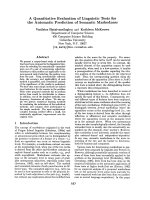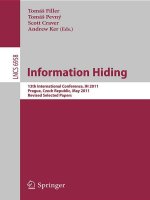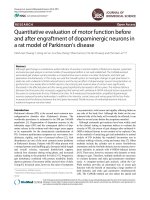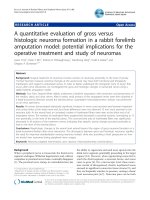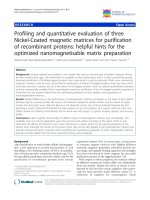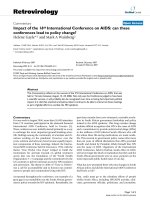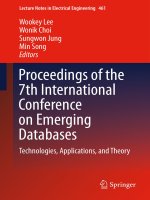Quantitative evaluation of systems 13th international conference, QEST 2016
Bạn đang xem bản rút gọn của tài liệu. Xem và tải ngay bản đầy đủ của tài liệu tại đây (16.38 MB, 385 trang )
LNCS 9826
Gul Agha
Benny Van Houdt (Eds.)
Quantitative Evaluation
of Systems
13th International Conference, QEST 2016
Quebec City, QC, Canada, August 23–25, 2016
Proceedings
123
Lecture Notes in Computer Science
Commenced Publication in 1973
Founding and Former Series Editors:
Gerhard Goos, Juris Hartmanis, and Jan van Leeuwen
Editorial Board
David Hutchison
Lancaster University, Lancaster, UK
Takeo Kanade
Carnegie Mellon University, Pittsburgh, PA, USA
Josef Kittler
University of Surrey, Guildford, UK
Jon M. Kleinberg
Cornell University, Ithaca, NY, USA
Friedemann Mattern
ETH Zurich, Zürich, Switzerland
John C. Mitchell
Stanford University, Stanford, CA, USA
Moni Naor
Weizmann Institute of Science, Rehovot, Israel
C. Pandu Rangan
Indian Institute of Technology, Madras, India
Bernhard Steffen
TU Dortmund University, Dortmund, Germany
Demetri Terzopoulos
University of California, Los Angeles, CA, USA
Doug Tygar
University of California, Berkeley, CA, USA
Gerhard Weikum
Max Planck Institute for Informatics, Saarbrücken, Germany
9826
More information about this series at />
Gul Agha Benny Van Houdt (Eds.)
•
Quantitative Evaluation
of Systems
13th International Conference, QEST 2016
Quebec City, QC, Canada, August 23–25, 2016
Proceedings
123
Editors
Gul Agha
University of Illinois
Urbana, IL
USA
Benny Van Houdt
University of Antwerp
Antwerp
Belgium
ISSN 0302-9743
ISSN 1611-3349 (electronic)
Lecture Notes in Computer Science
ISBN 978-3-319-43424-7
ISBN 978-3-319-43425-4 (eBook)
DOI 10.1007/978-3-319-43425-4
Library of Congress Control Number: 2015944718
LNCS Sublibrary: SL1 – Theoretical Computer Science and General Issues
© Springer International Publishing Switzerland 2016
This work is subject to copyright. All rights are reserved by the Publisher, whether the whole or part of the
material is concerned, specifically the rights of translation, reprinting, reuse of illustrations, recitation,
broadcasting, reproduction on microfilms or in any other physical way, and transmission or information
storage and retrieval, electronic adaptation, computer software, or by similar or dissimilar methodology now
known or hereafter developed.
The use of general descriptive names, registered names, trademarks, service marks, etc. in this publication
does not imply, even in the absence of a specific statement, that such names are exempt from the relevant
protective laws and regulations and therefore free for general use.
The publisher, the authors and the editors are safe to assume that the advice and information in this book are
believed to be true and accurate at the date of publication. Neither the publisher nor the authors or the editors
give a warranty, express or implied, with respect to the material contained herein or for any errors or
omissions that may have been made.
Printed on acid-free paper
This Springer imprint is published by Springer Nature
The registered company is Springer International Publishing AG Switzerland
Preface
Welcome to the proceedings of QEST 2016, the 13th International Conference on
Quantitative Evaluation of Systems. QEST is a leading forum on quantitative evaluation and verification of computer systems and networks, through stochastic models
and measurements. QEST was first held in Enschede, The Netherlands (2004), followed by meetings in Turin, Italy (2005), Riverside, USA (2006), Edinburgh, UK
(2007), St. Malo, France (2008), Budapest, Hungary (2009), Williamsburg, USA
(2010), Aachen, Germany (2011), London, UK (2012), Buenos Aires, Argentina
(2013), Florence, Italy (2014) and, most recently, in Madrid, Spain (2015).
This year’s QEST was held in Quebec City, Canada, and colocated with the 27th
International Conference on Concurrency Theory (CONCUR 2016) and the 14th
International Conference on Formal Modeling and Analysis of Timed Systems
(FORMATS 2016).
As one of the premier fora for research on quantitative system evaluation and
verification of computer systems and networks, QEST covers topics including classic
measures involving performance and reliability, as well as quantification of properties
that are classically qualitative, such as safety, correctness, and security. QEST welcomes measurement-based studies and analytic studies, diversity in the model formalisms and methodologies employed, as well as development of new formalisms and
methodologies. QEST also has a tradition in presenting case studies, highlighting the
role of quantitative evaluation in the design of systems, where the notion of system is
broad. Systems of interest include computer hardware and software architectures,
communication systems, embedded systems, infrastructural systems, and biological
systems. Moreover, tools for supporting the practical application of research results in
all of the aforementioned areas are also of interest to QEST. In short, QEST aims to
encourage all aspects of work centered around creating a sound methodological basis
for assessing and designing systems using quantitative means.
The Program Committee (PC) consisted of 30 experts and we received a total of 46
submissions. Each submission was reviewed by three reviewers, either PC members or
external reviewers. The review process included a one-week PC discussion phase. In
the end, 21 full papers and three tool demonstration papers were selected for the
conference program. The program was greatly enriched by the QEST keynote talk of
Carey Williamson (University of Calgary, Canada), the joint keynote talk with FORMATS 2016 of Ufuk Topcu (University of Texas at Austin, USA), and the joint
FORMATS 2016 and CONCUR 2016 keynote of Scott A. Smolka (Stony Brook
University, USA). We believe the overall result is a high-quality conference program of
interest to QEST 2016 attendees and other researchers in the field.
We would like to thank a number of people. Firstly, thanks to all the authors who
submitted papers, as without them there simply would not be a conference. In addition,
we would like to thank the PC members and the additional reviewers for their hard
work and for sharing their valued expertise with the rest of the community, as well as
VI
Preface
EasyChair for supporting the electronic submission and reviewing process. We are also
indebted to our proceedings chair, Karl Palmskog, and to Alfred Hofmann and Anna
Kramer for their help in the preparation of this volume. Thanks also to the Web
manager, Andrew Bedford, the local organization chair, and general chair, Josée
Desharnais, for their dedication and excellent work. Finally, we would like to thank
Joost-Pieter Katoen, chair of the QEST Steering Committee, for his guidance
throughout the past year, as well as the members of the QEST Steering Committee.
We hope that you find the conference proceedings rewarding and will consider
submitting papers to QEST 2017.
August 2016
Gul Agha
Benny Van Houdt
Organization
General Chair
Josée Desharnais
Université Laval, Canada
Program Committee Co-chairs
Gul Agha
Benny Van Houdt
University of Illinois, USA
University of Antwerp, Belgium
Local Organization Chair
Josée Desharnais
Université Laval, Canada
Proceedings and Publications Chair
Karl Palmskog
University of Illinois, USA
Steering Committee
Alessandro Abate
Luca Bortolussi
Javier Campos
Pedro D’Argenio
Boudewijn Haverkort
Jane Hillston
Andras Horvath
Joost-Pieter Katoen
William Knottenbelt
Gethin Norman
Anne Remke
Enrico Vicario
University of Oxford, UK
University of Trieste, Italy
University of Zaragoza, Spain
Universidad Nacional de Córdoba, Argentina
University of Twente, The Netherlands
University of Edinburgh, UK
University of Turin, Italy
RWTH Aachen University, Germany
Imperial College London, UK
University of Glasgow, UK
University of Twente, The Netherlands
University of Florence, Italy
Program Committee
Alessandro Abate
Nail Akar
Christel Baier
Nathalie Bertrand
Luca Bortolussi
Peter Buchholz
University of Oxford, UK
Bilkent University, Turkey
Technical University of Dresden, Germany
Inria Rennes, France
University of Trieste, Italy
Technical University of Dortmund, Germany
VIII
Organization
Ana Bušic
Javier Campos
Rohit Chadha
Florin Ciucu
Andres Ferragut
Dieter Fiems
Anshul Gandhi
Tingting Han
John Hasenbein
Jane Hillston
William Knottenbelt
Sasa Misailovic
Pavithra Prabhakar
Sriram Sankanarayanayan
M. Zubair Shariq
Evgenia Smirni
Mark Squillante
Tetsuya Takine
Peter Taylor
Miklós Telek
Enrico Vicario
Mahesh Viswanathan
Inria Paris, France
University of Zaragoza, Spain
University of Missouri, USA
University of Warwick, UK
Universidad ORT, Uruguay
Ghent University, Belgium
Stony Brook University, USA
Birkbeck, University of London, UK
University of Texas, USA
University of Edinburgh, UK
Imperial College London, UK
MIT, USA
Kansas State University, USA
University of Colorado Boulder, USA
University of Iowa, USA
College of William and Mary, USA
IBM, USA
Osaka University, Japan
University of Melbourne, Australia
Technical University of Budapest, Hungary
University of Florence, Italy
University of Illinois, USA
Additional Reviewers
Alexander Andreychenko
Benoît Barbot
Simona Bernardi
Laura Carnevali
Nathalie Cauchi
Diego Cazorla
Milan Ceska
Taolue Chen
Daniel Gburek
Blaise Genest
Elena Gómez-Martínez
Illes Horvath
Jean-Michel Ilié
Nadeem Jamali
Jorge Julvez
Charalampos
Kyriakopulous
Wenchao Li
Andras Meszaros
Dimitrios Milios
Laura Nenzi
Marco Paolieri
Elizabeth Polgreen
Daniël Reijsbergen
Ricardo J. Rodríguez
Andreas Rogge-Solti
Dimitri Scheftelowitsch
Sadegh Soudjani
Max Tschaikowski
Feng Yan
Abstracts of Invited Talks
A Stroll Down Speed-Scaling Lane
Carey Williamson
Department of Computer Science, University of Calgary, Calgary, AB, Canada
Abstract. This talk provides a retrospective look at the past, present, and future
of speed scaling systems. Such systems have the ability to auto-scale their
service capacity based on demand, which introduces many interesting tradeoffs
between response time (a classic performance metric) and energy efficiency (a
relatively recent performance metric of growing interest).
The talk highlights key results and observations from the past two decades
of speed scaling research, which appears in both the theory and systems research
communities. One theme in the talk is the dichotomy between the assumptions,
approaches, and results in these two research communities. Another theme is
that modern processors support surprisingly sophisticated speed scaling functionality, which is not yet well-harnessed by current algorithms or operating
systems.
During the stroll, I will also share some insights and observations from our
own work on speed scaling designs, including coupled, decoupled, and turbocharged systems. This work includes analytical and simulation modeling, as
well as empirical system measurements. The talk closes with thoughts about
future opportunities in speed scaling research.
V-Formation as Optimal Control
Scott A. Smolka
Department of Computer Science, Stony Brook University,
Stony Brook, NY, USA
Abstract. In this talk, I will present a new formulation of the V-formation
problem for migrating birds in terms of model predictive control (MPC). In this
approach, to drive a flock towards a desired formation, an optimal velocity
adjustment (acceleration) is performed at each time-step on each bird’s current
velocity using a model-based prediction window of T time-steps. I will present
both centralized and distributed versions of this approach. The optimization
criteria used is based on fitness metrics of candidate accelerations that V-formations are known to exhibit. These include velocity matching, clear view, and
upwash benefit. This MPC-based approach is validated by showing that for a
significant majority of simulation runs, the flock succeeds in forming the desired
formation. These results help to better understand the emergent behavior of
formation flight, and provide a control strategy for flocks of autonomous aerial
vehicles. This talk represents joint work with Radu Grosu, Ashish Tiwari, and
Junxing Yang.
Adaptable Yet Provably Correct
Autonomous Systems
Ufuk Topcu
Department of Aerospace Engineering and Engineering Mechanics,
University of Texas at Austin, Austin, TX, USA
Abstract. Acceptance of autonomous systems at scales at which they can make
societal and economical impact hinges on factors including how capable they
are in delivering complicated missions in uncertain and dynamic environments
and how much we can trust that they will operate safely and correctly. In this
talk, we present a series of algorithms recently developed to address this need. In
particular, these algorithms are for the synthesis of control protocols that enable
agents to learn from interactions with their environment and/or humans while
verifiably satisfying given formal safety and other high-level mission specifications in nondeterministic and stochastic environments.
We take two complementing approaches. The first approach merges data
efficiency notions from learning (e.g., so-called probably approximate correctness) with probabilistic temporal logic specifications. The second one leverages
permissiveness in temporal-logic-constrained strategy synthesis with reinforcement learning.
Contents
Markov Processes
Property-Driven State-Space Coarsening for Continuous Time
Markov Chains . . . . . . . . . . . . . . . . . . . . . . . . . . . . . . . . . . . . . . . . . . . .
Michalis Michaelides, Dimitrios Milios, Jane Hillston,
and Guido Sanguinetti
Optimal Aggregation of Components for the Solution of Markov
Regenerative Processes . . . . . . . . . . . . . . . . . . . . . . . . . . . . . . . . . . . . . .
Elvio Gilberto Amparore and Susanna Donatelli
Data-Efficient Bayesian Verification of Parametric Markov Chains . . . . . . . .
E. Polgreen, V.B. Wijesuriya, S. Haesaert, and A. Abate
3
19
35
Probabilistic Reasoning Algorithms
Exploiting Robust Optimization for Interval Probabilistic Bisimulation. . . . . .
Ernst Moritz Hahn, Vahid Hashemi, Holger Hermanns,
and Andrea Turrini
55
Approximation of Probabilistic Reachability for Chemical Reaction
Networks Using the Linear Noise Approximation . . . . . . . . . . . . . . . . . . . .
Luca Bortolussi, Luca Cardelli, Marta Kwiatkowska, and Luca Laurenti
72
Polynomial Analysis Algorithms for Free Choice Probabilistic
Workflow Nets . . . . . . . . . . . . . . . . . . . . . . . . . . . . . . . . . . . . . . . . . . . .
Javier Esparza, Philipp Hoffmann, and Ratul Saha
89
Queueing Models
Energy-Aware Server with SRPT Scheduling: Analysis and Optimization . . .
Misikir Eyob Gebrehiwot, Samuli Aalto, and Pasi Lassila
107
Dynamic Control of the Join-Queue Lengths in Saturated Fork-Join
Stations . . . . . . . . . . . . . . . . . . . . . . . . . . . . . . . . . . . . . . . . . . . . . . . . .
Andrea Marin and Sabina Rossi
123
Moment-Based Probabilistic Prediction of Bike Availability
for Bike-Sharing Systems . . . . . . . . . . . . . . . . . . . . . . . . . . . . . . . . . . . . .
Cheng Feng, Jane Hillston, and Daniël Reijsbergen
139
XVI
Contents
Tools
Attack Trees for Practical Security Assessment: Ranking of Attack
Scenarios with ADTool 2.0 . . . . . . . . . . . . . . . . . . . . . . . . . . . . . . . . . . .
Olga Gadyatskaya, Ravi Jhawar, Piotr Kordy, Karim Lounis,
Sjouke Mauw, and Rolando Trujillo-Rasua
Spnps: A Tool for Perfect Sampling in Stochastic Petri Nets . . . . . . . . . . . .
Simonetta Balsamo, Andrea Marin, and Ivan Stojic
CARMA Eclipse Plug-in: A Tool Supporting Design and Analysis
of Collective Adaptive Systems . . . . . . . . . . . . . . . . . . . . . . . . . . . . . . . .
Jane Hillston and Michele Loreti
159
163
167
Sampling, Inference, and Optimization Methods
Uniform Sampling for Timed Automata with Application to Language
Inclusion Measurement . . . . . . . . . . . . . . . . . . . . . . . . . . . . . . . . . . . . . .
Benoît Barbot, Nicolas Basset, Marc Beunardeau,
and Marta Kwiatkowska
Inferring Covariances for Probabilistic Programs . . . . . . . . . . . . . . . . . . . . .
Benjamin Lucien Kaminski, Joost-Pieter Katoen, and Christoph Matheja
Should Network Calculus Relocate? An Assessment of Current Algebraic
and Optimization-Based Analyses . . . . . . . . . . . . . . . . . . . . . . . . . . . . . . .
Steffen Bondorf and Jens B. Schmitt
175
191
207
Markov Decision Processes and Markovian Analysis
Verification of General Markov Decision Processes by Approximate
Similarity Relations and Policy Refinement . . . . . . . . . . . . . . . . . . . . . . . .
Sofie Haesaert, Alessandro Abate, and Paul M.J. Van den Hof
Policy Learning for Time-Bounded Reachability in Continuous-Time
Markov Decision Processes via Doubly-Stochastic Gradient Ascent. . . . . . . .
Ezio Bartocci, Luca Bortolussi, Tomǎš Brázdil, Dimitrios Milios,
and Guido Sanguinetti
Compact Representation of Solution Vectors in Kronecker-Based
Markovian Analysis. . . . . . . . . . . . . . . . . . . . . . . . . . . . . . . . . . . . . . . . .
Peter Buchholz, Tuǧrul Dayar, Jan Kriege, and M. Can Orhan
227
244
260
Networks
A Comparison of Different Intrusion Detection Approaches in an Advanced
Metering Infrastructure Network Using ADVISE. . . . . . . . . . . . . . . . . . . . .
Michael Rausch, Brett Feddersen, Ken Keefe, and William H. Sanders
279
Contents
XVII
Traffic Modeling with Phase-Type Distributions and VARMA Processes . . . .
Jan Kriege and Peter Buchholz
295
An Optimal Offloading Partitioning Algorithm in Mobile Cloud Computing . . .
Huaming Wu, William Knottenbelt, Katinka Wolter, and Yi Sun
311
Performance Modeling
Maintenance Analysis and Optimization via Statistical Model Checking:
Evaluating a Train Pneumatic Compressor . . . . . . . . . . . . . . . . . . . . . . . . .
Enno Ruijters, Dennis Guck, Peter Drolenga, Margot Peters,
and Mariëlle Stoelinga
331
Performance Evaluation of Train Moving-Block Control . . . . . . . . . . . . . . .
Giovanni Neglia, Sara Alouf, Abdulhalim Dandoush, Sebastien Simoens,
Pierre Dersin, Alina Tuholukova, Jérôme Billion, and Pascal Derouet
348
Decoupling Passenger Flows for Improved Load Prediction . . . . . . . . . . . . .
Stefan Haar and Simon Theissing
364
Author Index . . . . . . . . . . . . . . . . . . . . . . . . . . . . . . . . . . . . . . . . . . . .
381
Markov Processes
Property-Driven State-Space Coarsening
for Continuous Time Markov Chains
Michalis Michaelides1(B) , Dimitrios Milios1 , Jane Hillston1 ,
and Guido Sanguinetti1,2
1
School of Informatics, University of Edinburgh, Edinburgh, UK
2
SynthSys, Centre for Synthetic and Systems Biology,
University of Edinburgh, Edinburgh, UK
Abstract. Dynamical systems with large state-spaces are often expensive to thoroughly explore experimentally. Coarse-graining methods aim
to define simpler systems which are more amenable to analysis and exploration; most current methods, however, focus on a priori state aggregation based on similarities in transition rates, which is not necessarily
reflected in similar behaviours at the level of trajectories. We propose
a way to coarsen the state-space of a system which optimally preserves
the satisfaction of a set of logical specifications about the system’s trajectories. Our approach is based on Gaussian Process emulation and
Multi-Dimensional Scaling, a dimensionality reduction technique which
optimally preserves distances in non-Euclidean spaces. We show how
to obtain low-dimensional visualisations of the system’s state-space from
the perspective of properties’ satisfaction, and how to define macro-states
which behave coherently with respect to the specifications. Our approach
is illustrated on a non-trivial running example, showing promising performance and high computational efficiency.
1
Introduction
Reasoning about behavioural properties of dynamical systems is a central goal
of formal modelling. Recent years have witnessed considerable progress in this
direction, with the definition of formal languages [9,10] and logics [12] which
enable compact representations of dynamical systems, and mature reasoning
tools to model-check properties in an exact [15] or statistical way [14,20].
While such advances are indubitably improving our understanding of dynamical systems, the applicability of these techniques in practical scenarios is still
largely hindered by computational issues. In particular, systems with large statespaces quickly become infeasible to analyse via exact methods due to the phenomenon of state-space explosion; even statistical methods may require computationally expensive and extensive simulations. State-space reduction methodologies aim to construct more compact representations for complex systems. Such
M. Michaelides, D. Milios and G. Sanguinetti are supported by the European
Research Council under grant MLCS 306999. J. Hillston is supported by the EU
project, QUANTICOL 600708.
c Springer International Publishing Switzerland 2016
G. Agha and B. Van Houdt (Eds.): QEST 2016, LNCS 9826, pp. 3–18, 2016.
DOI: 10.1007/978-3-319-43425-4 1
4
M. Michaelides et al.
reduced-state systems are generally amenable to more effective analysis and may
yield deeper insights into the structure and dynamics of the system.
Broadly speaking, state-space reduction can be achieved by either model simplification, usually by abstracting some system behaviours into a simpler system,
or state aggregation, often by exploiting symmetries or approximate invariances.
A prime example of model simplification is the technique of time-scale separation,
which replaces a large system with multiple weakly dependent sub-systems [5].
Most aggregation methods, instead, are based on grouping different states with
similar behaviour with respect to their transition probabilities. This idea is at the
core of the concept of approximate lumpability, which extends the exact lumpability
relationship by aggregating states based on a pre-defined metric on the outgoing
exit rates [1,7,11,17,19].
In this paper we propose a novel state-space reduction paradigm by shifting
the focus from the infinitesimal properties of states (i.e. their transition rates)
to the global properties of trajectories. Namely, we seek to aggregate states that
yield behaviourally similar trajectories according to a set of pre-defined logical
specifications. Intuitively, two states will be aggregated if trajectories starting
from either state exhibit similar probabilities of satisfying the logical specifications. We define a statistical algorithm based on statistical model checking and
Gaussian Process emulation to define this behavioural similarity across the whole
state-space of the system. We then propose a dimensionality reduction and clustering pipeline to aggregate states and define reduced (non-Markovian) dynamics. To illustrate our approach, we give a running example of model reduction
for the Susceptible-Infected-Recovered-Susceptible (SIRS) model, a non-trivial,
non-linear stochastic system widely used in epidemiology. Our results show that
property-driven aggregation can yield an effective tool to reduce the complexity
of stochastic dynamical systems, leading to non-trivial insights in the structure
of their state-space.
2
2.1
Background
Population Continuous Time Markov Chains
A Continuous Time Markov Chain (CTMC) is a continuous-time Markovian stochastic process over a discrete state-space S. We will consider only population
models, where the state-space is organised along populations: in this case, the
state-space is indexed by the counts of each population ni ∈ N ∪ {0}. Population CTMCs (pCTMCs) are frequently used in many scientific and engineering
domains; we will use here the notation of chemical reactions as it is widespread
and intuitively appealing. Transitions in a pCTMC are denoted as
τ (X)
r1 X1 + . . . rn Xn −−−→ s1 X1 + . . . sn Xn
meaning that ri particles of type Xi are consumed and sj particles of type Xj
are produced when the specific transition takes place. τ (X) is a transition rate
which depends on the current state of the system.
Property-Driven State-Space Coarsening
5
It is easy to show that waiting times between transitions are exponentially
distributed random variables; this observation is the basis of exact simulation
algorithms for pCTMCs, such as the celebrated Gillespie algorithm [13]. The
Gillespie algorithm generates trajectories of a pCTMC by randomly choosing
the next reaction to occur and the time to elapse until the reaction occurs.
Example 1.1. We introduce here our running example, the Susceptible-InfectedRecovered-Susceptible (SIRS) model of epidemic spreading. The SIRS model is a
discrete stochastic model of disease spread in a population, where individuals in
the population can be in one of three states, Susceptible, Infected and Recovered.
There are different variations of the model, some open (individuals can enter and
exit the system), others with individuals relapsing to a susceptible state after
having recovered. Here, we consider a relapsing, closed system, which evolves
in a discrete, 2-dimensional state-space, where dimensions are the number of
Susceptible and Infected individuals in the population (Recovered numbers are
uniquely determined since the total population is constant). We also introduce a
spontaneous infection of a susceptible individual with constant rate, independent
of the number of infected individuals, to eliminate absorbing states.
With a population size of N , states in the 2D space can be represented by
x = (S, I), S ∈ {0, · · · , N }, I ∈ {0, · · · , N − S} for a total of (N + 1)(N + 2)/2
states. The chemical reactions for this system are:
α
→ 2I;
infection S + I −
β/5
spontaneous infection S −−→ I;
β
→ R;
recovery I −
β
→ S.
relapsing R −
We set the infection rate α = 0.005, recovery rate β = 0.01, and population
size N = S + I + R = 100, for a total of 5151 states in this SIRS system. Sample
trajectories of the system were simulated using the Gillespie algorithm.
2.2
Temporal Logic and Model Checking
We formally specify trajectory behaviours by using temporal logic properties. We
are particularly interested in properties that can be verified on single trajectories,
and assume metric bounds on the trajectories, so that they are observed only
for a finite amount of time. Metric Interval Temporal logic (MITL) offers a
convenient way to formalise such specifications.
Formally, MITL has the following grammar:
φ:: = tt | μ | ¬φ | φ1 ∧ φ2 | φ1 U[T1 ,T2 ] φ2 ,
where tt is the true formula, conjunction and negation are the standard boolean
connectives, and the time-bounded until U[T1 ,T2 ] is the only temporal modality. Atomic propositions μ are (non-linear) inequalities on population variables.
6
M. Michaelides et al.
A MITL formula is interpreted over a function of time x, and its satisfaction relation is given as in [16]. More temporal modalities, such as the timebounded eventually and always, can be defined in terms of the until operator:
F[T1 ,T2 ] φ ≡ ttU[T1 ,T2 ] φ and G[T1 ,T2 ] φ ≡ ¬F[T1 ,T2 ] ¬φ.
MITL formulae evaluate as true or false on individual trajectories; when
trajectories are sampled from a stochastic process, the truth value of a MITL
formula is a Bernoulli random variable. Computing the probability of such a random variable is a model checking problem. Model checking for MITL properties
evaluated on trajectories from a CTMC requires the computation of transient
probabilities; despite major computational efforts [15], this is seldom possible
exactly due to state-space explosion. Statistical model checking (SMC) methods
circumvent such problems by adopting a Monte Carlo perspective: by drawing
repeatedly and independently sample trajectories, one may obtain an unbiased
estimate of the truth probability, and statistical error bounds can be obtained by
employing either frequentist or Bayesian statistical approaches [14,20]. It should
be pointed out that such bounds do not carry the same guarantees as numerical results obtained say by transient analysis; however, simply by drawing more
samples one may reduce the uncertainty in the bounds arbitrarily.
Example 1.2. MITL formulae can be used effectively to obtain behavioural characterisations of the system’s trajectory. We turn again to the SIRS model to
illustrate this concept.
Assume one may want to express a global bound on the virulence of the
infection, so that the fraction of infected population never exceeds λ. This can
be done by considering the formula φ1 , defined as
φ1 :: = G[0,100] (I < λN )
(1)
which translates to:
φ1 (x) =
tt
if It < λN ∀t ∈ [0, 100],
¬tt otherwise.
Statistical model checking of this formula is trivial: one simply draws a trajectory
using Gillespie’s algorithm, and monitors that the maximal number of infected
does not exceed the specified threshold in the [0, 100] interval.
3
3.1
Methodology
High Level Method Description
We first present a high-level description of the proposed methodology; the technical ingredients will be introduced in the following subsections. Figure 1 provides an intuitive roadmap of the approach. The overarching idea is to provide
a state-space aggregation algorithm which uses behavioural similarities as an
aggregation criterion.
Property-Driven State-Space Coarsening
7
NI
3
1
Initial state space
NS
2
φ-calculation
NR
GP imputation
P (φ2 )
1
Property space (φ-space)
2
1
3
P (φ1 )
1
MDS projection
JSD as metric
1
P (φn )
MDS extension
θm
3
JSD space
1
θ1
Clustering
Cluster labelling
θm
3
JSD space
1
θ1
Fig. 1. The sequence of transformations from space to space are shown in the figure.
States from the original state-space (blue circles 1–3) are projected to φ-space according to satisfaction rate of set properties (found via simulation of the system). MDS
is used to project from φ-space to a space where JSD of φ satisfaction probability distributions between states is preserved as Euclidean distance (in the figure,
Pφ (3)] < JSD[Pφ (1)
Pφ (2)], JSD[Pφ (1)
Pφ (3)] so states 2, 3 are
JSD[Pφ (2)
placed closer together than 1). The states are then clustered to produce macro-states.
Out-of-sample states (red cross) can be projected to φ-space, using GP imputation to
estimate satisfaction probabilities. MDS extension allows projecting from φ-space to
JSD space without moving the sampled states. The most likely cluster for the state to
belong to (nearest centroid) is the macro-state it belongs to. (Color figure online)
8
M. Michaelides et al.
The input to the approach is a CTMC model and a set of MITL formulae
φ1 , . . . , φn which define the behavioural traits we are interested in. We formalise
some of the key concepts through the following definitions.
Definition 1. A coarsening map C for a CTMC M is a surjective map
M:S→
− R,
(2)
from the state-space S of M to a finite set R, such that card(S) ≥ card(R).
Definition 2. The macro-states of the coarsened system are the elements of the
image of the coarsening map C.
Therefore, the set of all macro-states is a partition of the set of initial states
S, where each element in the partition is a macro-state. In general, there is no
way to retrieve the initial state configuration of the system only from information
of the macro-state configuration, i.e., the coarsening entails an information loss.
We illustrate the various steps of the proposed procedure in Fig. 1. The first
step is to take a sample of possible initial states; we then evaluate the joint
satisfaction of the n formulae, given a particular state as initial condition. This
implicitly defines a map
n
Φ : S → [0, 1]2
(3)
which associates each initial state with the probability of each possible satisfaction pattern of the n formulae. Notice that all of the 2n possible truth values
are needed to ensure correlations between properties are captured. Constructing
such a property map by exhaustive exploration of the state-space is clearly computationally infeasible; we therefore evaluate it (by SMC) on a subset of possible
initial states, and then extend it using a statistical surrogate, a Gaussian Process
(Fig. 1 top).
The property representation contains the full information over the dependence of the properties of interest on the initial state. It can be endowed with
an information-theoretic metric by using the JSD between the resulting probability distributions. However, the high dimensionality and likely very non-trivial
structure of the property representation may make this unwieldy. We therefore
propose a dimensionality reduction strategy which maintains approximately the
metric structure of the property representation using Multi-Dimensional Scaling (MDS; Fig. 1 middle). MDS will also have the advantage of automatically
identifying potentially redundant characterisations, as implied for example by
logically dependent formulae.
The low-dimensional output of the MDS projection can then be visually
inspected for groups of initial states (macro-states) with similar behaviours with
respect to the properties. This operation is a coarsening map, which can also be
automated by using a variety of clustering algorithms.
The model dynamics induce, in principle, a dynamics on this reduced space
R. In practice, such dynamics will be non-Markovian and not easily expressible
in a compact form; we propose a simple, simulation-based alternative definition
which re-uses some of the computation performed in the previous steps to define
an empirical, coarse-grained dynamics on the macro-states.
Property-Driven State-Space Coarsening
3.2
9
Satisfaction Probability as a Function of Initial Conditions
The starting point for our approach consists of embedding the initial state-space
into the property space, φ-space. This is achieved by computing satisfaction
probabilities for the 2n possible truth patterns of the n properties we consider.
As in general these satisfaction probabilities can only be computed via SMC, this
is potentially a tremendous computational bottleneck. To obviate this problem,
we turn the computation of the property map into a machine learning problem:
we evaluate the 2n functions on a (sparse) subset of initial states, and predict
their values on the remaining initial states using a Gaussian Process (GP).
GPs have extensively been used in machine learning for regression purposes
and it is in this context they are used here. A GP is a generalisation of the multivariate normal distribution to function spaces with infinitely many dimensions;
within a regression context, GPs are used to provide a flexible prior distribution
over the set of candidate functions underpinning the hypothesised input-output
relationship. Given a number of input-output observations (training set), one
can use Bayes’s rule to condition the GP on the training set, obtaining a posterior distribution over the regression function at other input points. For a review
of GPs and their uses in machine learning, we refer the reader to [18].
In our setting, the input-output relationship is the property map from initial
states to satisfaction probabilities of the properties. This function is defined
over a discrete space, but we can use the population structure of the pCTMC to
embed the state-space S in a (subset) of RD for some D. We can then treat the
n
problem as a standard regression problem, learning a function fφ : RD → R2 .
Remark. GPs have already been used to explore the dependence of the satisfaction probability of a formula on model parameters in the so-called Smoothed
Model Checking approach [6]. There, the authors proved a smoothness result
which justified the use of smoothness-inducing GPs for the problem. It is easy
to see that such smoothness does not hold in general for the function fφ ; for
example, the probability of satisfying the formula x(0) > N has a discontinuity
at x = N . However, since we only ever evaluate fφ on a discrete set of points,
the lack of smoothness is not an issue, as a continuous function can approximate
arbitrarily well a discontinuous function when restricted to a discrete set.
Example 1.3. We exemplify this procedure on the SIRS example. We consider
here three properties of interest: the global bound encoded in formula φ1 defined
in equation (1), and two further properties encoded as
φ2 :: = F[0,60] G[0,40] (0.05N ≤ I ≤ 0.2N ),
φ3 :: = F[30,50] (I > 0.3N ).
(4)
(5)
Satisfaction of φ2 requires that the infection has remained within 5 to 20 %
of the total population for 40 consecutive time units, starting anytime in the
first 60 time units; satisfaction of φ3 requires that the infection peaks at above
30 % between time 30 and time 50.
10
M. Michaelides et al.
The property map in this case would have an 8-dimensional co-domain, representing the probability of satisfaction for each of the 23 possible truth values
of the three formulae. Figure 2 plots the probability of satisfaction for the three
formulae individually, as we vary the initial state. In this case, 10 % of all possible
initial states were randomly selected and numerically mapped to the property
space via SMC, while the satisfaction probabilities for the remaining 90 % were
imputed using GPs. We see that throughout most of the state-space the second property has low probability. Also it is of interest to observe the strong
anti-correlation between the first and third properties: intuitively, if there is
very high probability that the infection will be globally bounded below 40 % of
individuals, it becomes more difficult to reach a peak at above 30 %.
3.3
Dimensionality Reduction of Behaviours
Once states are mapped onto φ-space, reducing dimensionality of this space is
useful to remove correlations and redundancies in the properties tracked. Properties may often capture similar behaviour, leading to strong correlations in
their satisfaction probability. Reducing the dimensionality of the property space
mostly retains the information of how behaviour differs from state to state, eliminating redundancies. Moreover, reduced dimensional mappings can aid practitioners to visually identify structures within the state-space of the system.
In order to quantify the similarity of different initial states with respect to
property satisfaction, the Jensen-Shannon Divergence (JSD) between the probability distributions of property satisfaction is used as a metric. JSD is an information theoretic symmetric distance between probability distributions — the
higher the difference between the distributions, the higher JSD is. Between two
distributions, P, Q, JSD is defined as
JSD[P
Q] =
1
(KL[P
2
M ] + KL[Q
M ]),
where M = 0.5(P + Q) the average of the distributions, and KL[P
Q] =
P (i)
i P (i) log Q(i) , the Kullback-Leibler divergence.
The JSD enables us to derive a matrix of pairwise distances in property
space between different initial states. Such a distance is not Euclidean, and is
defined in the high-dimensional property space. To map the initial states in a
more convenient, low-dimensional space, we employ a dimensionality reduction
technique known as Multi-Dimensional Scaling (MDS) [4].
MDS has its roots in the social science literature; it is a valuable and widely
used tool in psychology and similar fields where data is collected by assessing
similarity between pairs.
Given some points X in an m-dimensional space, MDS finds the position
of corresponding points Z in an n-dimensional space, where usually n < m,
such that a given metric between points is optimally preserved. In the most
common case, (also known as Torgerson–Gower scaling or Principal Component
Analysis), the metric to be preserved is the Euclidean distance, and is preserved

